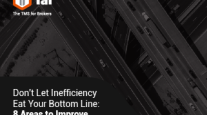Distracted Driving a Growing Challenge, Trucking and Technology Leaders Find
This story appears in the June 4 print edition of Transport Topics.
PRINCETON, N.J. — As mobile phones with transportation apps become more common in truck cabs, carriers face a growing safety and compliance challenge — making sure that their drivers aren’t using the devices while they’re on the road.
One way for fleets to address distracted driving is to track drivers’ phone use so they can see who is a risk, Matthew Howard, CEO and co-founder of ZoomSafer, said May 17 at the ALK Transportation Technology summit here.
“We can manage this because we can measure it,” said Howard, whose company offers products aimed at helping employers promote safe and legal use of their drivers’ mobile devices.
Christian Schenk, vice president of product marketing at Xata Corp., said studies show 86% of professional drivers carry a personal mobile device, with 44% using smart phones.
“You start to see our segment having an impact in the type of apps that are being downloaded,” he said.
About 18 months ago, a search for “transportation” apps yielded 438 applications on the Android market, but a few weeks ago, that number had grown to 14,216, Schenk said.
“It’s a profound statement that says the truck driver is a consumer,” he said. “They’re using these devices for purposes to improve their lives, to make better business decisions, to stay in connection with their family members.”
The influx of apps entering the transportation market offers carriers inexpensive ways to improve efficiency, but the widespread use of handheld devices also exposes employers to liability and compliance concerns, Howard said.
Employers whose truck drivers use handheld phones while driving could be hit with fines of up to $11,000 under a new Federal Motor Carrier Safety Administration regulation that went into effect Jan. 3.
“We’ve just got to be careful to make sure we’re not setting our drivers up to fail by putting it all out there on the cellphone,” said Greg Whisenant, transportation safety manager at Shaw Industries Group, a flooring company with its own private trucking fleet. “We’ve got to make sure they know they can’t touch that cellphone until they’re parked in a safe place.”
Whisenant said his company has taken a hard line on cellphone use while driving.
“We treat cellphones almost as serious as we do an accident,” he said. “We’re about two strikes and you’re out on the cellphone deal.”
Shaw Industries, Dalton, Ga., ranks No. 38 on the Transport Topics 100 list of the largest private carriers in the United States, Canada and Mexico.
Howard, of ZoomSafer, said his company offers a cellphone analytics service, called FleetSafer Vision, that combines mobile phone billing data with vehicle driving records — from companies such as Xata and PeopleNet — to create a report that empirically measures how and when a driver is using a phone.
However, Howard did acknowledge “a very delicate balance” be-tween making the driver’s life better and allowing employers to manage risk. He also touched on the sensitivity of telling drivers — who are “already regulated to the hilt” — to submit to a cellphone safety audit.
“I get the complexity,” he said. “All I’m simply saying is the data exists. It’s there.”
ZoomSafer also offers an active enforcement product, FleetSafer Mobile, which is generally for employers that issue company-owned devices to their drivers.
FleetSafer Mobile, software that installs on a BlackBerry or Android smart phone or tablet, automatically detects when an employee is driving a company vehicle and restricts phone use while the vehicle is moving.
Fleets also are dealing with other forms of distracted driving.
“Our safety people have determined about 40% of our accidents or incidents occur while our trucks are lost or looking for a customer,” said John Elliott II, CEO of expedited carrier Load One LLC, Taylor, Mich.
When a driver is going down the road, looking at building addresses, he’s not looking at what’s in front of him, he said.
Elliott said his company supplied its drivers with ALK’s CoPilot Truck navigation software — not only to cut fuel expenses and lost time but to improve safety by helping drivers find their way.
“Obviously, if the driver is on the right road, going the right way, going the right direction, things are going to work better all the way around,” he said.




